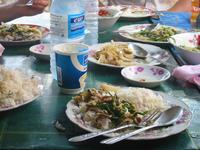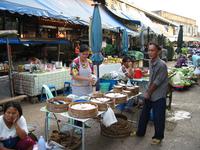


We like good food, and we like cycling in places where there is good food. And living near Newtown, we are generally in tune with Thai and Vietnamese cuisine (there is much less Cambodian in Sydney). Hence, we were looking forward to this trip from the culinary point of view as much as any other.
Throughout the trip we usually had lunch at some small shop at the roadside. Tanin in Thailand did an excellent job of taking us through quiet country areas, and in Cambodia everything outside the major cities is pretty rural anyway. Typically these places are family shops with a kitchen, a few tables and chairs outside under cover, mostly also some benches for lying down for a post-lunch nap (some wide enough for two). Certainly for cyclists a very sensible thing to do, as even in the coolest time of the year the mid-day sun is quite vicious.

|

|

|
| Siesta SE Asian style: lying on bamboo-lattice tables, on camp beds or even in hammocks (under a traditional Khmer house). | ||
In Thailand these shops are everywhere, in Cambodia it's slightly more difficult; particularly away from the main roads you will find an eating place only in the bigger villages. Food there is typically unsophisticated but nice. As a general observation, food in Cambodia is much less interesting than either in Thailand or in Vietnam. Our suspicion is that this is not an inherent difference (in fact, Cambodian cuisine tends to be halfway between Thai and Vietnamese) but a reflection of the generally low standard of living. Cambodians by and large can't afford sophisticated food. There were places where all we could find was some very plain noodle soup with offal (which we skipped ;-)

|

|

|
| Lunch in Thailand (left) and Cambodia (centre & right) | ||

|

|

|
The Vietnamese beer has already been mentioned...

|

|

|
Other popular drinks include: Really fresh coconut juice, and sweet soft drinks made from exotic fruit helping to keep our sugar levels up. And then there are Gernot's emergency supplies...
We thought we were used to all sorts of "exotic" fruit from the Sydney fruit and vege markets, but it turns out there is much we have never seen before.
 One example is the pamelo,
which was given to us by some Thai peasant who thought we were really cool
(or that is what we thought he thought and he might have actually thought
we were just crazy :-). It's like a big grapefruit with very thick skin and
very coarsely structured flesh but no bitter taste whatsoever. Later at
a food shop, the lady happily prepares the pamelo for us.
One example is the pamelo,
which was given to us by some Thai peasant who thought we were really cool
(or that is what we thought he thought and he might have actually thought
we were just crazy :-). It's like a big grapefruit with very thick skin and
very coarsely structured flesh but no bitter taste whatsoever. Later at
a food shop, the lady happily prepares the pamelo for us.
 The French influence is visible in Indochina in many things, most of all
the bread. In Cambodia as well as Vietnam one can get really decent
baguette, and in Saigon we even happen to come across a street-side bakery where we watch how
they make them.
The French influence is visible in Indochina in many things, most of all
the bread. In Cambodia as well as Vietnam one can get really decent
baguette, and in Saigon we even happen to come across a street-side bakery where we watch how
they make them.

 Apart from fresh fruit, conventional (sweet) snacks are offered on the roadside
as we stop for a short rest. Such as these rice cakes sold by a boy in Cambodia, and the
homemade ice cream sold by a Vietnamese
vendor just west of the border, both were a welcome treat.
Apart from fresh fruit, conventional (sweet) snacks are offered on the roadside
as we stop for a short rest. Such as these rice cakes sold by a boy in Cambodia, and the
homemade ice cream sold by a Vietnamese
vendor just west of the border, both were a welcome treat.
We went to a lot of very nice restaurants in Thailand, almost none of which would ever see any foreign tourists (certainly we never spotted any apart from ourselves). Tannin really did a great job there!
 One of the more interesting places is the resort we reach at
the end of our first full cycling day. It mostly caters for Bangkok
residents visiting the nearby white-water rafting attraction for the
week-end. We were the only guests
on Sunday night!
One of the more interesting places is the resort we reach at
the end of our first full cycling day. It mostly caters for Bangkok
residents visiting the nearby white-water rafting attraction for the
week-end. We were the only guests
on Sunday night!
The maybe most surprising fact about the food in Thailand was that it wasn't very hot, less so than what you get in some Sydney Thai restaurants, particularly those specialising on Isan cuisine. Since we were halfway between Bangkok and Isan (and there were definitely many dishes we were familiar with from Isan restaurants), we expected the spiciness to be similar. Even though we always asked the guide to order Thai taste (meaning "not toned down for white people") we found the food relatively mild. But it sure tasted nice!
 The culinary highpoint of Cambodia was Phnom Penh. We first had drinks at
the Foreign Correspondents' Club
(which it ain't, it's part of a Hong-Kong-based restaurant chain) and were
then taken to an excellent BBQ restaurant (no pictures I'm afraid).
The culinary highpoint of Cambodia was Phnom Penh. We first had drinks at
the Foreign Correspondents' Club
(which it ain't, it's part of a Hong-Kong-based restaurant chain) and were
then taken to an excellent BBQ restaurant (no pictures I'm afraid).

 Another BBQ restaurant, this time in Saigon, provided (in Gernot's opinion) the
best meal of the trip. Besides plenty of Ba-Ba-Ba (333) beer! food was
cooked at the table, on a little stove
full of red-hot charcoal. We ate wild boar, and a few other things we don't
remember for sure, but the menu also had snails, snakes, eel, frogs (we
had them in Siem Riep too), and lots of other things you won't find many
other places in a good restaurant. The place was huge, incredibly busy,
and we were, once again, the only whites!
Another BBQ restaurant, this time in Saigon, provided (in Gernot's opinion) the
best meal of the trip. Besides plenty of Ba-Ba-Ba (333) beer! food was
cooked at the table, on a little stove
full of red-hot charcoal. We ate wild boar, and a few other things we don't
remember for sure, but the menu also had snails, snakes, eel, frogs (we
had them in Siem Riep too), and lots of other things you won't find many
other places in a good restaurant. The place was huge, incredibly busy,
and we were, once again, the only whites!
At another Saigon dinner we were introduced to the local drinking ceremony (by a noisy bunch of locals at another table who repeated it frequently): Mot-hai-ba-jo! (one-two-three-down!), yelled in unison...


 Markets are fascinating places, and particularly so in South-East
Asia. Our first experience was the one in the Thai town of Sa Kaew. Most
of it is under a roof (obviously necessary in the Wet Season) but there
are plenty of traders setting up shop on the road.
Markets are fascinating places, and particularly so in South-East
Asia. Our first experience was the one in the Thai town of Sa Kaew. Most
of it is under a roof (obviously necessary in the Wet Season) but there
are plenty of traders setting up shop on the road.

 The lady at the right offers, besides normal fish,
a bowl of eels. She happily removesthe netting
when she realises we were taking photographs.
The lady at the right offers, besides normal fish,
a bowl of eels. She happily removesthe netting
when she realises we were taking photographs.
 Trading continued with
lights on once
it was getting towards the evening—buzz unabated.
Trading continued with
lights on once
it was getting towards the evening—buzz unabated.
 The “smiling” pig's heads are a somewhat
The “smiling” pig's heads are a somewhat
 unusual sight, one wonders what they are used for. But so is this
pharmacy just outside the market: besides
the usual pills it sells beer! (On prescription only?)
unusual sight, one wonders what they are used for. But so is this
pharmacy just outside the market: besides
the usual pills it sells beer! (On prescription only?)
 This market in Cambodia is somewhat different. It is also under a roof (tin
or tarpaulins), but without artificial lights (electricity is still a
luxury item not always readily available). Consequently it starts
shutting down at dusk, around 17:30, as it gets dark quickly inside. We
buy some fruit at incredibly low prices (for example 1 Baht for a hand
of lady finger bananas). There we also find out that Riel, the nominal
currency in the country, actually exists in Western Cambodia, but
everything is quoted in Baht (except in restaurants where menu prices
are in US$) and Riel are simply traded at 100 to 1 Baht—making life
simple. Similarly, US dollars are generally traded at 4000 Riel.
This market in Cambodia is somewhat different. It is also under a roof (tin
or tarpaulins), but without artificial lights (electricity is still a
luxury item not always readily available). Consequently it starts
shutting down at dusk, around 17:30, as it gets dark quickly inside. We
buy some fruit at incredibly low prices (for example 1 Baht for a hand
of lady finger bananas). There we also find out that Riel, the nominal
currency in the country, actually exists in Western Cambodia, but
everything is quoted in Baht (except in restaurants where menu prices
are in US$) and Riel are simply traded at 100 to 1 Baht—making life
simple. Similarly, US dollars are generally traded at 4000 Riel.
A lot of the produce is displayed on the floor and people are crouching on the ground or sometimes sitting on small stools.
 The centrally located Ben Than market in Saigon is not altogether a pleasant
affair, with traders aggressively trying to flog T-shirts to anyone
looking like a tourist (and we definitely are). Best to move quickly
further inside, where things are somewhat quieter.
The centrally located Ben Than market in Saigon is not altogether a pleasant
affair, with traders aggressively trying to flog T-shirts to anyone
looking like a tourist (and we definitely are). Best to move quickly
further inside, where things are somewhat quieter.
One of the most memorable impressions of that market are the shops that sell nothing but chopsticks. We are left with the impression that people use a different colour every day :-)
Return to main page of Bangkok to Saigon Cycle Challenge 2003